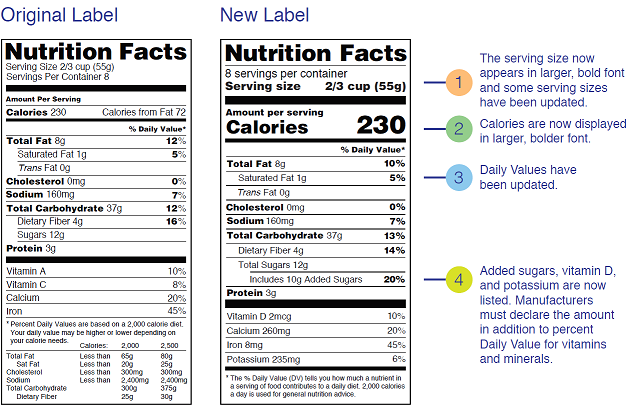How to Read the 2020 Nutrition Labels
Eating healthy can be challenging, particularly during the recent events of COVID-19. Stress-eating and eating because of boredom are pervasively evident based on interactions with my patients and even within my own community.
The refreshed design and updated information on the nutrition facts label appearing on all packaged foods and drinks will make it easier to make informed food choices that contribute to lifelong healthy eating habits. So, what are the highlights?

Serving size is more realistic and prominent
The serving sizes have been updated to better reflect the amount people typically consume today. NOTE: The serving size is not a recommendation of how much to eat.
Calorie display is larger and bolder; calories from fat have been removed
Note the calorie count, but also consider where those calories are coming from. The calories in a healthy fat such as an avocado are healthier than the calories in a saturated fat such as butter. Substituting avocados as a spread on sandwiches or toast instead of using butter can boost your intake of potassium and reduce your intake of saturated fat, cholesterol and sodium. NOTE: A serving size is a 1/3 of a medium avocado.
Added sugars
The original label listed only total sugars, which included both added and natural sugars. The new label allows consumers to determine how much sugar has been added during the processing of foods, foods packaged as sweeteners such as table sugar, sugars from syrups or honey, and sugars from concentrated fruit or vegetable juices.
Natural sugars are healthier than added sugars. Fruit and dairy are both natural sugars and provide valuable nutrients, whereas added sugars provide no nutritional value. Foods that contain them are often high in calories, digest quickly and provide little to no satiety.
Nutrients
Vitamins A and C have been removed from the label because deficiencies of these vitamins are rare today. Vitamin D and potassium have been added as many Americans do not meet the recommended intake.
Sources of vitamin D include salmon, fortified milk and eggs. Sources of potassium include avocados, spinach, sweet potatoes, beets, pomegranate and white beans like cannellini beans.
Calcium and iron remain listed on the label. Sources of calcium include dairy, fortified almond and soy milk, spinach, broccoli, tofu and almonds, to name a few. Sources of iron include red meat, oysters, fortified breakfast cereals, quinoa, spinach and white button mushrooms.
Daily Values
The percent Daily Value (%DV) shows how much a nutrient in a serving of food contributes to a total daily diet. Daily Values for nutrients have been updated, which may make the percent Daily Value higher or lower on the new nutrition facts label. As a general guide:
• 5% DV or less of a nutrient per serving is considered low.
• 20% DV or more of a nutrient per serving is considered high.
Personalize the label
Use the revised food label to get more of the nutrients you personally need and to get less of the nutrients you may want to limit. Choose foods that are higher in fiber, Vitamin D, calcium, iron and potassium. Limit added sugars, saturated fat and sodium.
Other guidelines to keep in mind:
- For adults, aim for at least 25-30 grams of fiber a day, 15 mcg (600 IU) of Vitamin D, 1,000-1,500 mg calcium and 4,700 mg potassium. For iron, adult males should aim for 8 mg per day. Adult females ages 19-50 should aim for 18 mg per day, and for females 51 and over should aim for 8 mg per day.
- Limit added sugars to no more than 5 grams per food item or less than 10% of calories per day. For example, for a 2,000 calorie diet limit added sugars to no more 200 calories or less than 50 grams per day.
- Limit saturated fat to no more than 15 grams per day for a 2,000 calorie diet.
- Limit sodium to 2,300 mg per day.









